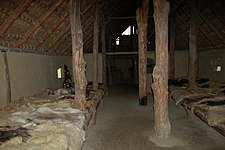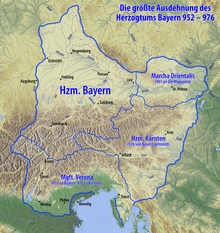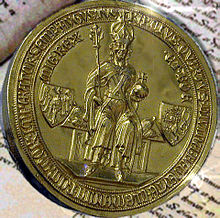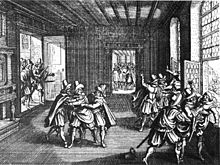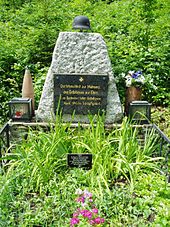History of Lower Austria
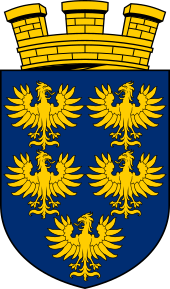
The history of Lower Austria coincides as Lower Austria , the heartland of the present Republic of Austria is, in many eras with Austrian history . This article shows the region-specific peculiarities and the development towards today's state .
Geological times
The area of today's Lower Austria lay for millions of years in and on the marginal sea Paratethys , on the fault line between Laurasia and Gondwana , the primary continents that had formed from the last supercontinent Pangea . The alpine mountain formation was formative for the geology of Lower Austria .
antiquity
Middle Paleolithic and Upper Paleolithic
The first traces of human settlement in Lower Austria come from the Middle Paleolithic and are around 60,000 years old. These are primitive tools that Neanderthals left behind in the Gudenus Cave and the Devil's Gaps . More finds are from the Upper Paleolithic (around 40,000–9,700 BC). The best known is the Venus von Willendorf , mainly hunting weapons were found. The hunters and gatherers lived mainly in the area along the Danube, there were already migrant settlements for 30 to 100 people, initially around caves and rock roofs. Large grazing areas were needed to find enough food and preferred areas with poor forest growth. During the Mesolithic Age (around 9,700–4,500 BC) living conditions improved due to a sharp rise in temperature. Devices made of wood, bone and horn as well as larger stone axes were found. People began keeping dogs as pets, hunting with bows and arrows, fishing with harpoons, fishing rods and nets, and gathering fruit.
Neolithic
The Neolithic Age, in which humans became settled, lasted in Lower Austria from around 5500 to 2200 BC. The first permanent farmers' settlements emerged, growing various types of grain for bread production as well as beans, lentils, peas and poppy seeds. Aside from the fields that were worked with simple tools, apples and pears were also cultivated. Goats, sheep and pigs, and later horses and cattle, were kept on animals, and like common flax , sheep's wool was used to make clothes. The quality of wood and stone processing was improved, and women and animals as well as the first clay pots were created. Most of the settlement areas can be found in the Weinviertel . They consisted of already more solid houses with stables and storage tanks (see long houses ), which stood together in small villages that could be built in the vast mixed oak forest after clearing. One can assume different tribes, perhaps also different cultures, in the Lower Austria area at this time. Around 5000 BC BC, towards the end of the linear ceramic culture , the Schletz massacre occurred on the site of today's village of Schletz (municipality of Asparn an der Zaya ) , which killed more than 200 people of all ages. Since around 2000 BC There were drastic social changes when, for the first time, higher hierarchical, aristocratic leadership groups emerged. This is concluded from settlement finds that no longer consist of many small houses, but are grouped around a central location such as a cave. The oldest hill fort with a diameter of 400 m was excavated in Falkenstein . During the Neolithic Age, people in Lower Austria were already working with copper, and the dead were often buried in a crouched position. The main sites are in the eastern Waldviertel and south of the Danube. Towards the end of the Neolithic Age, Vienna and areas in the south of the city also seem to have been more heavily populated.
The so-called band ceramic culture , which was spread all over Central Europe, was established in Lower Austria around 3,900 BC. Superseded by the Lengyel culture , from which examples of cannibalism are known. Since around 2500 BC The funnel cup culture took its place. Around 1900 it was replaced by the corded ceramics , around 1800 the bell-beaker culture , which originated in Spain and soon dominated, reached Lower Austria. The Baden culture also falls into this period, the use of wagons is already documented for them.
Bronze age
The Bronze Age lasted in Lower Austria from around 1,800 to 800 BC. There was the Urnfield period and the Hallstatt period . For example, Bronze Age graves from the Aunjetitz cultural area were discovered in the Weinviertel near Schleinbach , the finds of which are kept in the Museum of Prehistory in Asparn an der Zaya .
Iron age
The Iron Age lasted in Lower Austria from around 800 BC. Until the turn of the ages.
Celts
In early history and antiquity in the 2nd century BC BC Celts lived in the Lower Austrian foothills of the Alps and established the first and only Celtic state structure with Noricum . The Celtic peoples gradually had to give way to the growing influence of the Roman Empire in the Alpine region and were finally finally subjected to the Pannonian uprising around the year 8 AD.
Romans
The region of today's Lower Austria south of the Danube was incorporated into the Roman province of Pannonia , and in the course of the 1st century AD the garrison town of Carnuntum grew into the provincial capital. To this day, the ruins are a tourist attraction. The Heidentor near Carnuntum is the only building from Roman times that has been preserved above ground. During this time, the Limes was built along the Danube as a defensive wall towards the north. There are also some preserved remains such as in Tulln or Zeiselmauer . The Roman influence declined with the migration and disappeared completely at the end of the 6th century.
middle Ages
Origin of the Marcha Orientalis
After the collapse of the Roman Empire, the Asian people of from the 6th century had Avars and the hard-pressed by the Avars Slavs from the east or southeast Coming former Roman provinces Pannonia and Noricum partially populated. Around the same time, the Agilolfingers formed the first Bavarian tribal dynasty from the middle of the 6th century , which extended their territory from their seat in Regensburg to the east to the Enns and south to today's South Tyrol by the middle of the 8th century .
In 788, the Frankish king, Charlemagne, incorporated the previously independent Duchy of Bavaria into his empire. To the east of it he built the so-called Avarsmark around 800 and to the south of it the Karantanien region , which, given as a fief, should serve to protect his empire against the Avars advancing from the east. After the succession conflicts among Karl's successors and the resulting Treaty of Verdun in 843, the Duchy of Baiern with the two brands finally belonged to Eastern Franconia . The province of Marcha Orientalis , “Mark in the East”, established in the area of the former Avarmark, extended on both sides of the Danube from the Enns in the west to the March and Leitha in the east.
In the 10th century, the East Franconian kings had to defend themselves against the Magyars advancing from the east to Central Europe , until they withdrew after their defeat in the Battle of Lechfeld in 955.
Ostarrîchi among the Babenbergers
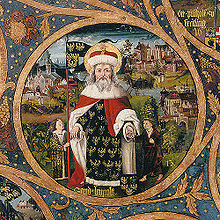
Twenty years later, around 975, the Babenberg dynasty established itself in the Marcha Orientalis ; It is believed that the founder of this dynasty, Liutpold , Count of the Donaugau, was appointed Count of Marchia Orientalis by Emperor Otto II as a reward for his loyalty during the Bavarian uprising in 976 . Liutpold and his successors - the Babenbergs ruled until 1246 - gradually expanded their territory at the expense of the Hungarians in particular. The margraviate was also referred to as Ostarrîchi (later spelling: Austria), which is considered the vernacular translation for Marchia Orientalis .
Especially Margrave Leopold III. (later canonized, today the patron saint of the country) earned great merits in the reclamation of the country through his founding monasteries (especially Klosterneuburg Abbey ) . The acquisition of space in the area of the Vienna Woods and to the east of it was also expressed in the relocation of the residence of the margraves, which was moved from Pöchlarn first to Melk , then to Klosterneuburg , before Heinrich II made Vienna the capital of the margraviate in 1142 . In 1156 Ostarrîchi was raised to duchy through the Privilegium Minus . With the expansion of the Babenberg rule to Styria in 1192, the history of Austria began for large areas west of the Enns.
With the death of the last Babenberger, Duke Frederick II the Arguable in the Battle of the Leitha in 1246, there was a dispute over the succession between his sister Margarete and his niece Gertrud , who resided in Alland in the Vienna Woods . Margarete ultimately won through her marriage to Ottokar II Přemysl , who was able to unite the Babenberg countries with Bohemia . Ottokar continued to colonize the country, including by founding new cities.
Lower Austria becomes Habsburg
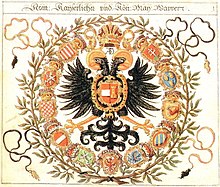
In 1278, after the battle of the Marchfeld , the area came under Habsburg rule and became their heartland. Since the Habsburgs had been passed over in the Golden Bull , they tried to achieve a position similar to that of the elector in another way . Duke Rudolf IV had a forgery made with the Privilegium Maius , in which the country was elevated to an archduchy . This was only recognized by Emperor Friedrich III on January 6, 1453 . who was a Habsburg himself.
Approaches to an administrative division of the Duchy of Austria along the Enns can already be found in Ottokar Přemysl , but it was only under the Habsburgs that separate estates for the land above the Enns in Linz were established . After the death of Ladislaus Postumus in 1458 Friedrich III. Austria under the Enns (also: nied der Enns ), today's Lower Austria, awarded, while his brother Albrecht VI. Austria ob der Enns (today's Upper Austria ) received. Nevertheless, both territories were considered to be two parts of the same Archduchy until the February patent in 1861 , only then did Austria become an independent Archduchy on the Enns.
In the late Middle Ages and in the early modern period , the Lower Austrian area was constantly affected by unrest, starting with the inheritance disputes of the Habsburgs around 1400, over the Hussite Wars and the constant attempts by Frederick III. , up to the invasions of the Hungarian king Matthias Corvinus in the 15th century. Many of these struggles took on a life of their own and the "feuds" were generally perceived as a plague that brought public order to the brink of dissolution. Only Ferdinand I was able to restore order, albeit at a high price: the cities were stripped of all self-government and protests were nipped in the bud , as at the Wiener Neustadt blood court .
In 1349, the plague reduced the population in Lower Austria by around 20% and many settlements were abandoned as part of the restructuring of the manorial estates.
Modern times
At the beginning of modern times , when Lower Austria was still under the rule of the House of Habsburg , two events were decisive for the further development of the country: The Reformation movement that emerged at the beginning of the 16th century - Protestantism found particularly broad resonance in Lower Austria - and the threat by the Ottomans .
The country was badly affected by the first Turkish siege of Vienna in 1529 . The area around Vienna was hit hard by the Akıncı , a 20,000-strong cavalry troop serving the Ottomans . The result was a drastic population decline throughout Lower Austria.
The Counter-Reformation did not begin in the country that had become Protestant until the 1570s, but then with great vehemence. The main protagonists were the Jesuits , who took over schools and universities. Cardinal Melchior Khlesl , the secretary of the later Emperor Matthias, was an important figure in the re-Catholicisation . To preserve their political and religious freedoms, the Protestant estates concluded an alliance in 1619 with the estates of the Kingdom of Bohemia (joining the Confoederatio Bohemica ), which was directed against the Habsburg sovereign Emperor Ferdinand II . Before that, however, they had tried to force him to conclude a peace with the rebellious Bohemians and to make concessions in matters of faith with the so-called storm petition . At first only the Catholic minority remained loyal to the emperor. The military defeat of the Protestants in the Battle of White Mountain paved the way for the forcibly enforced Counter-Reformation in Lower Austria as well. The submissive population had to change back to the Catholic faith without exception in the 1920s. Only a few Protestant nobles who had not participated in the uprising against the emperor were spared. The other evangelical lords and knights had to leave the country if they did not convert. Their property was given to Catholic supporters of the emperor. The clergy gained in importance again through the Counter-Reformation, important monasteries were Melk Abbey , Klosterneuburg and Göttweig Abbey .
The Thirty Years' War seemed to have little effect on Lower Austria for a long time, only at the beginning of this long war, when Count Heinrich Matthias von Thurn advanced with the army of the rebellious Bohemians on Vienna, some places along today's Brünner Strasse were looted. Towards the end of the war, however, things got far worse: the last great battle of the Thirty Years' War took place near Jankau in Bohemia, about 60 km southeast of Prague . On March 6, 1645, a defeated Swedish -protestantisches army under Field Marshal Lennart Torstensson the Imperial - Habsburg forces under Field Marshal Melchior Count of Hatzfeld , which was open for the Swedes the way to Vienna. The Swedish troops devastated large parts of the Weinviertel, and several castles such as Staatz and Falkenstein have been in ruins since then . The Gaunersdorf market , which is today's Gaweinstal , was completely burned down like Stockerau . The cities of Krems , Korneuburg and Stein in turn suffered severe damage and loss of life as a result of Swedish attacks and the subsequent recapture by the imperial forces.
After the Battle of Mohács in 1526 and the subsequent collapse of the Hungarian kingdom, Lower Austria became the border area of the Holy Roman Empire and remained so until 1683, when the Ottomans were pushed back after the unsuccessful Second Siege of Vienna . Since the population had suffered the heaviest losses from the Turkish army of up to 300,000 men - Vienna had around 20,000 inhabitants at that time - large parts of Lower Austria were resettled by charcoal burners , lumberjacks and farmers from Styria , the Salzkammergut , Upper Austria and Tyrol , Bavaria and Swabia , for example in St. Corona , Klausen-Leopoldsdorf , Hochstraß and Pressbaum .
During this time, the mansions of the country nobility were rebuilt or expanded in the baroque style ; so z. B. Artstetten Castle , which was greatly expanded around 1710, or Hof Castle , which Prince Eugen bought and enlarged in 1726.

Even after the threat from the Ottomans no longer existed, Lower Austria was not spared from battles and wars. In addition to the devastation caused by the Kurucs at the beginning of the 18th century and the later invasions of the Prussians - most recently in 1866 - the Napoleonic Wars of 1805 and 1809 were of particular importance for Lower Austria. In the run-up to and around the Lower Austrian events of the Battle of Aspern and the Battle of Wagram , the still predominantly rural population was looted and raped.
In the course of the industrial revolution , the railway network with the center in Vienna was established, starting with the Kaiser Ferdinand's northern railway , the first section of which, (Vienna) Floridsdorf - Deutsch-Wagram , opened in 1837 as Austria's first steam railway. (The Northern Railway remained the most important railway line in Lower Austria until the end of the monarchy in 1918.) From 1854 on, the Semmering Railway opened up the mining area in eastern Styria , Eastern Railway and Western Railway connected this with the emerging industries in Bohemia , Upper and Lower Austria and the agricultural sector embossed Hungary . Region of kk imperial capital Franz Joseph I. benefited from it and was characterized with the focal point of intellectual and artistic potential in Central Europe. The fin de siècle shaped the country architecturally and culturally. This atmosphere still lives today. B. through the tragedy of Crown Prince Rudolf in Mayerling , the Art Nouveau buildings in Neuhaus , villas on Semmering and the Biedermeier buildings in Baden .
Civil society, administration
With the administrative separation of Upper Austria from the heartland of Austria , Ottokar II. Přemysl created the later federal state of Lower Austria as an administrative unit at the end of the 13th century.
However, while the Babenbergs until 1246 and Ottokar until 1278 had exclusively delegated the judiciary to court and land taidingen , in the course of the 14th century these developed into state parliaments which also advised the princes on military and tax matters. This council had the right to complain and petition and the possibility of legislative initiatives. However, the laws themselves were enacted by the Prince himself by patent .
In addition to the princely Erbämtern marshal , chamberlain , steward and butler administrative authorities incurred by the estates . The members of the state parliaments of the landscape of the late Middle Ages and modern times were on the one hand aristocratic, landed lords and knights and clerical dignitaries such as provosts and abbots in the prelate class . The fourth stand was also represented in the stand order by the mayor, monastery chief or city judge.
In 1513 the Lower Austrian estates bought a palace from the Liechtensteiners , today's Palais Niederösterreich , in Herrengasse in Vienna, which was converted into a country house and administrative center. In the middle of the 18th century, Maria Theresa and the Josephine reforms caused the estates to lose many of their competencies, which they only partially regained under Leopold II (1790–1792).
After the Napoleonic Wars , the Congress of Vienna 1814/15 and the Metternich system in Biedermeier , the March Revolution of 1848 brought the resignation of Emperor Ferdinand I , the end of the representation of the estates and the return to centralism and absolutism - the restoration of the monarchy under the new, young emperor Franz Joseph I. dawned.
In the Archduchy of Austria under the Enns , the first elected state parliament of Lower Austria met on April 6, 1861 . Due to the census suffrage , which was tied to a certain tax payment by the voter, barely ten percent of the inhabitants of Lower Austria elected the 66 members of the state parliament. The basis of the constitution, state regulations and state election regulations was the imperial February patent of the same year, which severely curtailed the old powers of the state parliaments in favor of the Reichsrat , and essentially until the end of the k. u. k. Monarchy in the value change of the First World War was valid.
20th century
1918-1938
After the First World War and the break-up of Austria-Hungary , Lower Austria became a border region in late autumn 1918. The German-populated southern Moravia (from which the later Austrian Federal Presidents Karl Renner and Adolf Schärf came) wanted to join German Austria and Lower Austria in 1918 , but this part of the country was quickly occupied by Czech troops. In St. Germain it was then definitely determined that South Moravia should belong to Czechoslovakia, regardless of the majority population's German mother tongue. This had a negative effect on political stability and population satisfaction.
The newly formed Czechoslovakia also demanded the cession of Lower Austrian territory, which it had largely already occupied from November 1918, and was awarded this on September 10, 1919 in the Treaty of Saint-Germain . In the negotiations of St. Germain, on which the representatives of German Austria had almost no influence, while the Czechs were counted among the victorious powers, the entire area of the Lundenburg – Grusbach railway and the Gmünder Hauptbahnhof were claimed by Czechoslovakia, although the affected railway lines were Part of it ran in Lower Austria (see Feldsberg ), because at the time of construction nobody could have expected that this state border could ever become a state border. Austria offered Czechoslovakia the re-routing of the route across Moravian territory at its own expense, which was rejected by the Czechoslovak side. In the peace treaty of St. Germain, the town of Feldsberg, where the Lower Austrian Wine Academy was located, was awarded to the neighboring communities in the northeastern Weinviertel of Czechoslovakia; the Austrian railway junction Gmünd (see also České Velenice ) had to be rebuilt in the area of the Waldviertel that remained with Austria .
From 1934 onwards, the territory of Lower Austria, newly won by the Czechoslovak Republic in 1919, was also subject to the planning and execution of the Czechoslovak Wall , which was primarily intended to protect itself against the expanding National Socialist German Reich . Work on it was stopped in 1938 when Czechoslovakia had to cede the German-settled border areas to the German Reich due to the Munich Agreement .
Lower Austria's traditional economic and transport links to Bohemia and Moravia were affected by the new state border that was established in 1918, which had a negative impact on the fragile post-war economy.
Lower Austria became the largest and most populous of the seven federal states of the new republic ( Burgenland was not yet part of Austria) and received a social democratic Viennese, Albert Sever , as governor because Vienna was part of the state. In order to reduce the dominance of Lower Austria in the federal structure and to resolve the contrast between predominantly red capitals and black farmers, the federal government , which was adopted on October 1, 1920 and entered into force on November 10, 1920 , was primarily due to the urging of the Lower Austrian Farmers' Union - Vienna Constitutional Act defined as a separate federal state from that day on; on that day it also passed its own city and state constitution. The mayor of Vienna was now also governor of Vienna.
After about a year of separation negotiations, which focused on public facilities and previously shared property, Sever resigned in November 1921. At the end of December 1921, the Vienna Landtag, which had existed since November 10, 1920, and the Lower Austrian Landtag without Viennese MPs passed in separate processes the Separation Act , which was the same in both countries and came into force on January 1, 1922. (The historic Lower Austrian country house in Vienna's Herrengasse only became the sole property of Lower Austria in 1995.) Thus, Lower Austria no longer had an official capital, but the provincial administration remained in Vienna.
Two events belonging to the whole of Austrian history took place in Lower Austria between the First and Second World War: the Korneuburg Oath , with which the fight against democratic parliamentarism and the party state was declared, and the detention camp in Wöllersdorf , where the corporate state held opponents prisoner.
1938-1945
In the period of National Socialism from 1938 to 1945, any reference to the Austrian name disappeared; according to the Ostmark Act of April 14, 1939 , the country was called Gau Niederdonau . Vienna remained the administrative seat, but Krems was elevated to the status of the "Gau capital". From May 1938 until the end of the war, Hugo Jury was Gauleiter of the Niederdonau Gau . With the formation of Greater Vienna in autumn 1938, Lower Austria lost the municipalities surrounding Vienna, which were the economically strongest areas. The South Moravia annexed by the German Reich on October 1, 1938 after the Munich Agreement ( imposed on Czechoslovakia ) belonged to the Lower Danube Gau from April 15, 1939 to May 8, 1945. Hitler had Burgenland dissolved; the cities of Eisenstadt and Rust and the districts of Eisenstadt , Mattersburg , Neusiedl am See and Oberpullendorf were also added to the Niederdonau district on October 15, 1938 and remained there until autumn 1945.
In the Waldviertel , many people around Döllersheim were resettled, the area was declared an army restricted area and the largest military training area in the German Reich was established. Combat units for the east were put together here and storage areas for booty were set up. Landowners were expropriated for this purpose. Due to its strategically favorable position, heavy industry, such as aircraft construction, which was important for the war effort and which was heavily bombed by the Allies during World War II in 1944/1945 , was located along the thermal line . Wiener Neustadt in particular was repeatedly the target of the American bomber fleets. Camps for slave labor were also set up near the armaments factories . The final Soviet offensive (Battle of Vienna) against the Wehrmacht troops took place in the first half of April 1945.
After the end of National Socialism , the newly formed state authorities in Lower Austria registered 84,795 National Socialists on the basis of the Prohibition Act 1945, of which around 2000 NSDAP officials were arrested. Due to the amended provisions in the Prohibition Act 1947 6920 persons were classified as stressed classified 76,400 as less burdened .
1945 – today
The Red Army occupied Vienna and all of Eastern Austria. The victorious Allied powers agreed to add Lower Austria to the Soviet zone of occupation and made Vienna - within the borders of 1937 - a four-sector city . In 1946, Vienna, Lower Austria and the National Council decided to return many of the towns that were incorporated into Greater Vienna in 1938 to Lower Austria. Due to a veto by the Soviet occupying power, this law could only be promulgated and come into force in 1954.
The collapse of the Third Reich in 1945 was particularly hard hit in eastern Lower Austria. Bombing, fighting, destruction, looting, rape and the occasional arrest and kidnapping of politically unpopular people by Soviet forces shaped the first post-war years. This, as well as the ten-year Soviet occupation and the incorporation of many companies into the USIA group, complicated and slowed down reconstruction. As a result, Lower Austria fell behind the western federal states. Free political and economic development was only possible after the withdrawal of the Soviet occupation troops in 1955 after the conclusion of the Austrian State Treaty .
At the beginning of the sixties, under the Deputy Governor and at the same time Newag General Director Viktor Müllner, the Südstadt was built south of Vienna . NEWAG and Niogas, later merged to form EVN , set up their headquarters in the southern part of the city . A sports center serves u. a. to build up top athletes ( Liese Prokop trained there). Residential and terraced houses in the countryside completed the settlement near Triester Straße (B17), which belongs to the municipality of Maria Enzersdorf.
The catching-up process did not lead to a close match with the federal states that had been under Western Allied occupation until 1975 under Governor Andreas Maurer , and caused a fundamental change in the economic and social structure of the country. The share of agriculture fell sharply, while the service and industrial sectors in the outskirts of the cities grew enormously.
The resulting rural exodus to the metropolitan areas of Vienna and Linz made the lack of a regional capital more and more felt as a lack. In 1986, the Landtag , under the leadership of Governor Siegfried Ludwig, decided to conduct a referendum to resolve the capital issue of Lower Austria . St. Pölten was finally raised to the state capital after an extensive advertising campaign and the positive referendum . Renowned architects, including Hans Hollein and Klaus Kada , designed a new government district and the cultural center with museum and festival hall . The Lower Austrian authorities were moved step by step to St. Pölten, the state government itself moved in 1996. Gustav Peichl built a new ORF state studio in St. Pölten . With the decision to have its own provincial capital, more money remained in the state, and - just as a little later with the fall of the Iron Curtain - the prosperity of Lower Austria was promoted.
See also
Individual evidence
- ↑ This section follows: Karl Gutkas: History of the Province of Lower Austria. 6th edition. Niederösterreichisches Pressehaus Druck- und VerlagsgesmbH, St. Pölten 1983, pp. 11–12.
- ↑ a b This section follows: Karl Gutkas: Geschichte des Landes Niederösterreichs , 6th edition, Niederösterreichisches Pressehaus Druck- und VerlagsgesmbH, St. Pölten 1983, pp. 12-13.
- ↑ Manfred Rosenberger in the newspaper Au-Blick of the Donau-Auen National Park, issue no.35
- ^ Walter F. Kalina: Ferdinand III. and the fine arts. A contribution to the cultural history of the 17th century. (Dissertation University of Vienna 2003), 16.
- ↑ Andrea Heigl: Vienna and Lower Austria: Two unequal countries, united in wild marriage on derstandard.at , December 26, 2012. Retrieved on December 27, 2012.
- ^ German Reichsgesetzblatt 1939, p. 745 f., Law of March 25, 1939
- ↑ Law on territorial changes in Austria, GBlLÖ No. 443/1938
- ^ Air raid on Wiener Neustadt on October 1, 1943 , website regiowiki.at, accessed on November 22, 2014
- ↑ Christian Klösch: The national camp in Lower Austria 1918-1938 and 1945-1996 . In: Stefan Eminger, Ernst Langthaler (Hrsg.): Lower Austria in the 20th century. tape 1 : politics. Böhlau, Vienna 2008, ISBN 978-3-205-78197-4 .
literature
- Lower Austrian bibliography .
- Karl Gutkas : State Chronicle of Lower Austria. 3000 years in data, documents and images . 2nd Edition. Brandstätter, Vienna 1994, ISBN 3-85447-254-4 .
- Karl Gutkas: History of Lower Austria (= history of the Austrian federal states). Edited by Johann Rainer. Publishing house for history and politics, Vienna 1984, ISBN 3-7028-0209-6 .
- Walter Kohl (ed.), Andreas Weber: Experienced history of Lower Austria . NP-Buchverlag, St. Pölten / Vienna / Linz 2004, ISBN 3-85326-359-3 .
- Gerhard Stenzel (Ed.): Lower Austria. History and culture in pictures and documents . Otto Müller Verlag, Salzburg 1982, ISBN 3-7013-0637-0 .
- Lower Austrian Institute for Regional Studies: The Romans in Lower Austria. Twenty-fourth symposium of the Lower Austrian Institute for Regional Studies. 5th to 8th July 2004. Tulln on the Danube, Minorite Monastery (= Archaeological Research in Lower Austria , Volume 5). 2008, ISBN 978-3-901635-16-8 .
historical monographs (by date):
- Jos. M. Frhr. v. Liechtenstern : Statistical-geographical description of the Archduchy of Austria under the Ens. Kleinmeier, Vienna / Leipzig 1791.
- Ignaz de Luca : The Archduchy of Austria. 1. Volume of the Geographical Handbook of the Austrian State. Verlag Joseph V. Degen, Vienna 1791, Das Land Unter der Ens , pp. 79–428 ( Google eBook, full view ).
- Franz [Xavier Joseph] Schweickhardt Ritter von Sickingen : Presentation of the Archduchy of Austria under the Ens,… 34 volumes, 1831–1841 ( detailed online sources ).
- WCW Blumenbach : Latest regional studies of Austria Unter der Ens. 2 volumes, 2nd edition, Verlag Carl Reichard, Kőszeg (Güns) 1834/35 (Google eBook, complete view: 1st volume, 2nd volume ) - with a literature compilation, volume 1, p. 26 ff.
Web links
The central scientific facility for the documentation of the history of Lower Austria can be found in
- Lower Austria State Archives .
- The museums of Lower Austria
- Regional studies of Lower Austria
- History of Lower Austria
- History database of the Lower Austrian State Museum


